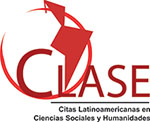Anólisis comparativo de la utilización de refrigerantes alternativos en un chiller
DOI:
https://doi.org/10.23857/dc.v4i1.753Palabras clave:
chiller, anticongelante, refrigerante secundario, refrigeración, sistemas indirectos, nanos fluidos.Resumen
Los sistemas de refrigeración representan un gran consumidor de energía por lo cual en la bíºsqueda de eficiencia en el consumo energético no solo se debe estudiar el diseño de nuevos sistemas sino también se deben analizar y mejorar los sistemas existentes. En este caso se analiza la utilización de distintos refrigerantes secundarios en equipos chiller. Este anólisis se centra en el estudio del comportamiento y características de distintos refrigerantes secundarios con la finalidad de mostrar alternativas de refrigerantes secundarios al momento de seleccionar un fluido para una aplicación, dependiendo de los requerimientos del usuario.
Citas
Alí©, J.V.,& Santos,G.A. 2000. Congresso de Ar Condicionado Refrigeracao, Aquecimento e Ventilacao do Mercosul. 2000.
ASHRAE. 2015. ASHRAE, Advance energy desing guides. [En línea] ASHRAE, 2015. www.ashrae.org/aedg..
—. 2010. Handbook - Refrigeration. Atlanta : American Society of Heating, Refrigerating and Air-Conditioning Engineers, Inc., 2010. págs. 46-66. 978-1-933742-82-3.
Bahrami, M. 2017. Evaluation of low - pressure flooded evaporator performance for absorption chillers. 2017. págs. 144-158. Vol. 122.
Barreiro, Jose y Sandoval, Aleida. 2006. Operaciones de conservacion de alimentos por bajas temeraturas. Caracas : Editorial Equinoccio, 2006.
Bejarano, Guillermo, y otros. 2013. Modelado simplificado y orientado al control de sistemas de redrigeración. Terrassa : s.n., 2013.
Carrier Air Conditioning Company. 1980. Manual de Aire Acondicionado. Barcelona : Marcombo, 1980. págs. 389-392.
Chang, C, Whang, C y Shieh, C. 2007. Experimental study of a solid adsorption cooling system using flat-tube heat exchangers as adsorption bed. 2007. págs. 2195-2199. Vol. 27.
Chang, W, Wang, C y Shied, C. 2009. Desing and performance of a solar powered heating and cooling system using silica gel adsorption chiller. 2009. págs. 2100-2105. Vol. 29.
Diaz Torres, Y. 2014. Analisis energetico de un sistema hibrido de produccion de frio. 2014. págs. 38-49. Vol. XXXVI.
Franco Lijó, Juan Manuel. 2006. Manual de Refrigeración. Barcelona : Reverte, 2006. págs. 1-185.
—. 2006. Manual de Refrigeración. Barcelona : Reverte, 2006.
Hernández, Eduardo. 2010. Fundamentos de aire acondicionado y refrigeración. Mexico : LIMUSA, 2010.
Hong, Tianzhen. 2009. A close look at the China Design Standard for Energy Efficiency of Public Buildings. 2009, Vol. 41, 41, págs. 426-435.
Ignatowicz, Monika. 2008. Corrosion aspects in indirect systems with secondary refrigerants. Master of Science Thesis. Stockholm, Sweden : s.n., 2008. pág. 69.
Kabeel, A.E. 2017. Performance evaluation of energy efficient evaporatively ais-cooled chiller. 2017. págs. 204-213. Vol. 22.
Liu, M. S, Lin, M y Liaw, J. 2009. Performance Augmentation of a Water Chiller System Using Nanofluids. ASHRAE Transactions. 2009, Vol. 115, págs. 581-586.
Martinez-Pí©rez, F.J. 2014. III SEMINARIO INTERNACIONAL DE CIENCIAS APLICADAS. 2014. págs. 4-6.
Melinder, í…. 2010. Properties and Other Aspects of Aqueous Solutions Used for Single Phase and Ice Slurry Applications. s.l. : Elsevier, 2010. págs. 1506-1512. Vol. 33.
—. 2000. Update on Secondary Refrigerants for Indirect Systems. 2000, Vol. 2, págs. 1-2.
Powell, Kody, y otros. 2013. Optimal chiller loading in a district cooling system with thermal energy storage. 2013. págs. 445-463. Vol. 50.
Prabhakaran, M, y otros. 2016. Development and Assessment of Ceria-Propylene Glycol Nanofluid as an Alternative to Propylene Glycol for Cooling Applications. s.l. : Elsevier, 2016. págs. 329-335. Vol. 102.
Ruz, Mario L, y otros. 2016. Planta experimenltal para supervision y control del ciclo de refrigeracion por compresion de vapor. Madrid : CEA-IFAC, 2016. págs. 308-315.
s/a. 2012. Cost-benefit analysis of using cold thermal energy storage systems in building applications. 2012, Vol. 14, 14, págs. 493-501.
Saha, B y Kashiwagi, T. 1997. Experimental investigation of an advanced adsorption refrigeration. 1997. págs. 50-58.
Sam, K, Lam, K y Tham, C. 2017. Distributed Pumping Chilled Water Hydronic System for Air-conditioning Systems. 2017. págs. 88-93. Vol. 143.
Stoecker, Wilbert F. 1998. Industrial Refrigeration Handbook. New York : McGraw-Hill, 1998. págs. 113, 169-173, 248, 653-664.
Thangavelu, Raj. 2017. Energy optimization methodology of multichiller plant in commercial buildings. 2017. págs. 64-76. Vol. 123.
Wang, Shan K. 2000. Handbook of Air Conditional and Refrigeration. Second. New York : McGraw-Hill, 2000. págs. 403-462.
Wang, X. Q y Mujumdar, A.S. 2007. Heat transfer characteristics of nanofluids: a review. 2007, Vol. 46, 1, págs. 1-19.
Wexler, Philip. 2014. Encyclopedia Of Toxicology. London : Elsevier, 2014. págs. 3766-3767, 1915.
Yu, W. F. 2017. Review of standars of energy performance of chhiller systems serving commercial buildings. 2017. págs. 144-158. Vol. 122.
—. 2018. Theorical and experimental analyses of mist precooling for an air-cooled chiller. 2018. págs. 112-119. Vol. 130.
Publicado
Cómo citar
Número
Sección
Licencia
Authors retain copyright and guarantee the Journal the right to be the first publication of the work. These are covered by a Creative Commons (CC BY-NC-ND 4.0) license that allows others to share the work with an acknowledgment of the work authorship and the initial publication in this journal.







